STE Highlights, October 2019
Awards and Recognition





- Carlsten awarded APS 2020 Robert R. Wilson Prize in particle accelerators
- Gollapinni receives DOE Office of Science Early Career Research Award
- Sarrao named to New Mexico Technology Research Collaborative board
- Azad appointed 2020 Fellow of The Optical Society
- Zapf, Zhu, and Ecke named American Physical Society outstanding referees
Chemistry
Technical strides in colloidal quantum dots
First polar organic functionality reduction mediated by vanadium catalysts
Computer, Computational and Statistical Sciences
‘Hackathon’ brings DOE labs together to solve CMIP data analysis challenge
Materials Science and Technology
Material semi-coherent interfaces impact properties, both desirable and undesirable
Awards and Recognition
Carlsten awarded APS 2020 Robert R. Wilson Prize in particle accelerators
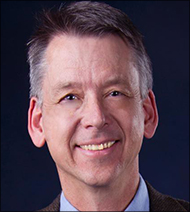
Bruce Carlsten
Bruce Carlsten, of the Associate Laboratory Directorate of Physical Sciences (ALDPS), is the 2020 recipient of the American Physical Society’s (APS) Robert R. Wilson Prize for Achievement in the Physics of Particle Accelerators. Open to all members of the scientific community in the U.S. and abroad, this award is the premiere recognition of achievement in the accelerator science and technology field.
Carlsten was cited for “the discovery and subsequent implementation of emittance compensation in photoinjectors that has enabled the development of high brightness, x-ray free electron lasers such as the Linac Coherent Light Source.” He is the first LANL recipient of this prize, which will be presented in May 2020 at the 2020 International Particle Accelerator Conference in Caen, France.
The research impact
Carlsten has been conducting accelerator research at the Laboratory for over 35 years and is both a Laboratory and an APS Fellow. He is currently developing novel technologies for X-ray free-electron lasers; developing high-efficiency, high-power radio-frequency sources for DOE’s Office of Science; and developing compact accelerators and applications for NNSA.
Accelerators are essential tools for the Laboratory’s Stockpile Stewardship mission, and accelerator science and technology is recognized as a core LANL capability. The Laboratory’s main accelerator facilities include LANSCE, an 800-mega-electronvolt accelerator that provides proton beams to five user facilities, and DARHT, a dual-axis electron induction linac for dynamic hydrotesting.
Additionally, the Lab addresses other nuclear and national security missions with smaller accelerators throughout the campus. LANL pioneered the field of bright electron beams, and its continued excellence in this field will enable the Lab to address future urgent stockpile stewardship missions, including developing a Dynamic Mesoscale Materials Science Capability (DMMSC, formerly MaRIE).
About the prize: Wilson’s legacy
The prize is named after Robert Wilson, who headed the Los Alamos cyclotron group during the Manhattan Project. Wilson revolutionized particle accelerators by building the first synchrotron with strong focusing at Cornell University. Wilson went on to become the first director of Fermilab in Batavia, Illinois, and was responsible for building its original accelerator, touting the highest energy in the world at that time.
Technical contact: Bruce Carlsten
Gollapinni receives DOE Office of Science Early Career Research Award
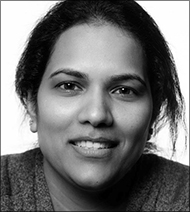
Sowjanya Gollapinni
Sowjanya Gollapinni, of Subatomic Physics (P-25) was granted a five-year Department of Energy (DOE) Office of Science 2019 Early Career Research Award. Gollapinni was one of 73 awardees, of which 27 were from DOE national laboratories and 46 were from U.S. universities.
Gollapinni brings her award from the University of Tennessee, Knoxville, where she was a faculty member in the Department of Physics and Astronomy before joining LANL earlier this year.
The Office of High Energy Physics selected her research (which will be carried out at LANL) for funding because she is focused on developing a laser-based calibration system for the Deep Underground Neutrino Experiment (DUNE).
DUNE is an international collaboration seeking to answer the question of why we live in a matter-dominated universe. DUNE is comprised of more than 1,000 scientists and researchers from more than 30 countries.
“I feel ecstatic with the news,” Gollapinni said of the award. “It comes with a lot of responsibility and an opportunity to make a leading contribution to the DUNE experiment. I am very excited for the resources and support I will receive through this award from the DOE.”
Sarrao named to New Mexico Technology Research Collaborative board
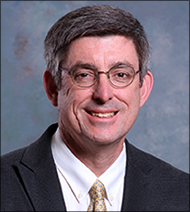
John Sarrao
John Sarrao, Los Alamos Deputy Director of Science, Technology, and Engineering, was named to the 2020 New Mexico Technology Research Collaborative (TRC) board. The TRC promotes tech commercialization in New Mexico, investing in early-stage science and technology that will diversify the economy. Sarrao’s participation in TRC supports the Laboratory’s commitment to promoting STE and a viable local economy.
TRC funds New Mexico’s future tech
Formalized in 2003 by the New Mexico Economic Development Department (NMEDD), the TRC aims to bring together collaborators from New Mexico’s research universities and laboratories. These experts help determine which technologies are the best strategic investments, leading to high-paying, sustainable jobs for New Mexicans.
“TRC’s role is more important today than ever before,” says Bruce Krasnow of NMEDD, “because the state is working quickly to diversify our economy, expanding in bioscience, technology, smart manufacturing, aerospace, cybersecurity, and data analytics.”
Sarrao’s role in TRC
Sarrao, who has worked at LANL for almost 30 years, will offer STE guidance on behalf of the Laboratory. His goal is to foster “a more vibrant entrepreneurial and economic ecosystem in the state.” Specifically, Sarrao joins other TRC board members to evaluate grant proposals from startup and maturing businesses and make recommendations on funding.
“I’m excited to serve on the TRC,” Sarrao says, “because helping to foster innovation and enhance regional partnerships with the Laboratory is fundamentally important.”
Technical contact: John Sarrao
Azad appointed 2020 Fellow of The Optical Society
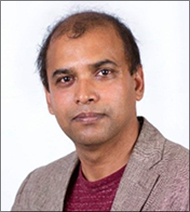
Abul Azad
Abul Azad, of the Center for Integrated Nanotechnologies (MPA-CINT), was named a 2020 fellow of The Optical Society (OSA).
Each year, fellowship is limited to 0.5% of total OSA membership. The selection is made by the society’s board of directors and recognizes members who have served the organization and the optics and photonics communities with distinction. This honor has been bestowed upon more than 2,500 OSA members since 1959.
Azad was recognized for his original pioneering contributions to the research and development of terahertz metamaterials, few-layer metasurfaces, active metamaterials, and terahertz plasmonics in subwavelength hole-arrays.
Azad is a staff scientist on CINT’s Laboratory for Ultrafast Materials and Optical Science (LUMOS) team. He engineers quasi two-dimensional metamaterials, which are designed to have electromagnetic properties not found in nature, such as negative refraction, electromagnetic cloaking, arbitrary wavefront shaping, and advanced photon management.
His work contributes to CINT’s nanophotonics and optical nanomaterials science thrusts and supports the Laboratory’s Energy Security mission and Materials of the Future science pillar by advancing efforts to develop materials with tailored properties and predictable performance.
Technical contact: Abul Azad
Zapf, Zhu, and Ecke named American Physical Society outstanding referees

Vivien S. Zapf (National High Magnetic Field Laboratory-Pulsed Field Facility, MPA-MAGLAB), Jian-Xin Zhu (Physics of Condensed Matter and Complex Systems, T-4), and Robert E. Ecke (Center for Nonlinear Studies, T-CNLS) were selected as 2019 outstanding referees by the American Physical Society (APS).
Referees keep the Physical Review journal standards at a high level by reviewing submitted manuscripts and helping authors improve the quality and readability of their articles. This year, Zapf, Zhu, and Ecke were among the 148 outstanding referees chosen from a pool of 71,000 referees. They stood out because of the quality, number, and timeliness of their reports.
According to the APS announcement, “The selection for this achievement is always difficult, and APS expresses its appreciation to all referees that help make the Physical Review collection some of the most cited physics journals in the world.”
The honor of outstanding referee is symbolic of the outstanding service these scientists offer to the physics community.
Technical contacts: Vivien Zapf, Jian-Xin Zhu, Robert Ecke
Bioscience
New flow cytometry technique for engineering future algal biofuels
One of the challenges in developing viable algal biofuels is determining which strains are best suited for bioengineering. “Tweaking” the right strain can lead to a viable platform to establish sustainable advanced biofuels and products, thus reducing our need for fossil fuels.
Finding the needle in a haystack: a tailored technique
To fast-track the process of finding good strain candidates and understanding their complex metabolic interactions, Los Alamos researchers developed new fluorescence-based high-throughput flow cytometry protocols. The characterization data achieved with this method offers a bigger picture on algal health and function.
Previous characterization methods offered minimal assessments, such as cell size, optical density, and cell counts. The new tailored methods offer greater detail, including cell morphology, membrane permeability, metabolic activity, cell viability, intracellular pH, and reactive oxygen species. Specifically, these researchers investigated the algal species Picochlorum soloecismus, which was selected by National Alliance for Advanced Biofuels and Bioproducts for its potential as a platform strain.
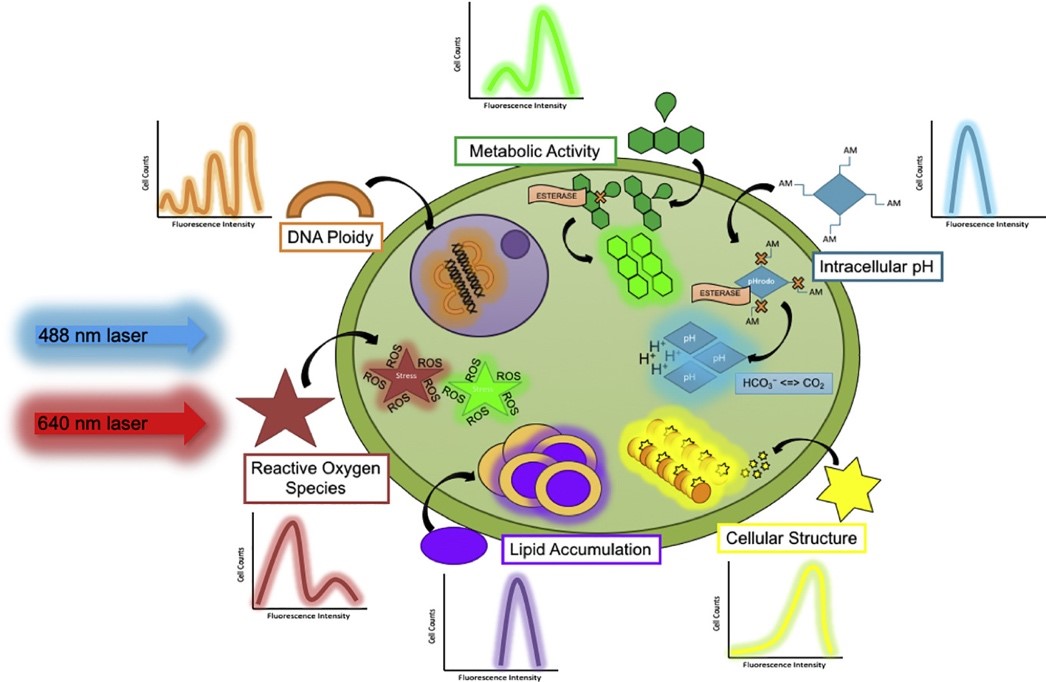
Developing a suite of flow cytometry techniques tailored to specific algae strains offered a deeper understanding into algae characterization for future biofuels.
Enhanced traits require enhanced data acquisition
Three different types of P. soloecismus (wildtype and two different isolates) were investigated under various environmental conditions and assessed with the new techniques to determine how each performs in terms of desired biofuel characteristics:
- outdoor robustness,
- growth rate,
- tolerance to environmental variability,
- increased production or utilization of available and abundant nutrients,
- and minimized input costs.
The researchers were able to track algal physiology and function within the isolates; this information is essential to developing optimized genetic mutants for maximum productivity. The techniques will also aid in evaluating how algae strains react after bioengineering takes place.
These novel techniques were challenging to engineer because algae possess complex cell structure, such as recalcitrant cell walls and high autofluorescence interference. The success of this research significantly broadens the data and understanding in the field of biofuels.
Funding and missions
This research was funded by the DOE Office of Energy Efficiency and Renewable Energy under contract from the Bioenergy Technologies Office. The work supports the Laboratory’s Energy Security mission area and the Materials of the Future science pillar.
Reference: Christina R. Steadman Tyler, Claire K. Sanders, Reece S. Erickson, Taraka Dale, Scott N. Twary, and Babetta L. Marrone (all B-11), “Functional and phenotypic flow cytometry characterization of Picochlorum soloecismus,” Algal Research. Available online Sept. 6, 2019: https://doi.org/10.1016/j.algal.2019.101614. Technical contact: Christina R. Steadman
Capability Enhancement
Crossroads supercomputer on track to be most efficient in the world
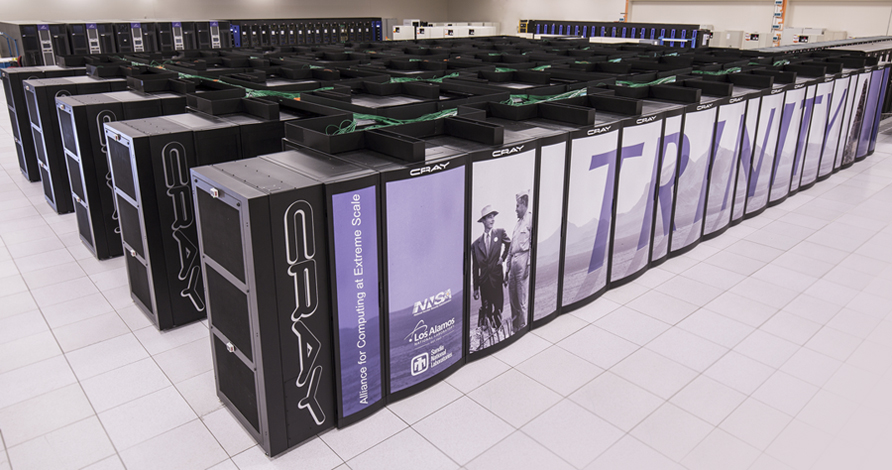
The Trinity supercomputer—made of 110 cabinets and 20,000 nodes—is the current workhorse for large-scale simulations, but the pace of technology will quickly surpass its capabilities in the 2021–2022 timeframe. Some parts from Trinity, such as precious metals, will be recycled.
Although speed used to be the parameter by which supercomputers were judged, a new variable has come into play: efficiency. Leveraging emerging technologies, the Crossroads supercomputer will improve application and workflow efficiency to better accomplish the Stockpile Stewardship mission. When efficiency is increased, more mission-critical work can get done.
“Crossroads will still be a very fast supercomputer,” says Jim Lujan, Crossroads program manager at Los Alamos, “but we are really focused on how much of that speed will be usable.”
Who will use Crossroads?
The new supercomputer will be housed at LANL, replacing Trinity, but it will also be used by Sandia National Laboratories and Lawrence Livermore National Laboratory. Crossroads is the third supercomputer attained under the New Mexico Alliance for Computing at Extreme Scale (ACES); the first two were Cielo and Trinity.
Researchers from all three laboratories will use Crossroads to run a variety of multi-physics weapons simulations codes. Some of these run jobs are quite large, taking weeks, months, or even years to finish. Crossroads will be designed to run one to four simulation codes simultaneously, getting jobs in and out efficiently and with high fidelity. These simulations are critical to guaranteeing the reliability of our nation’s stockpile.
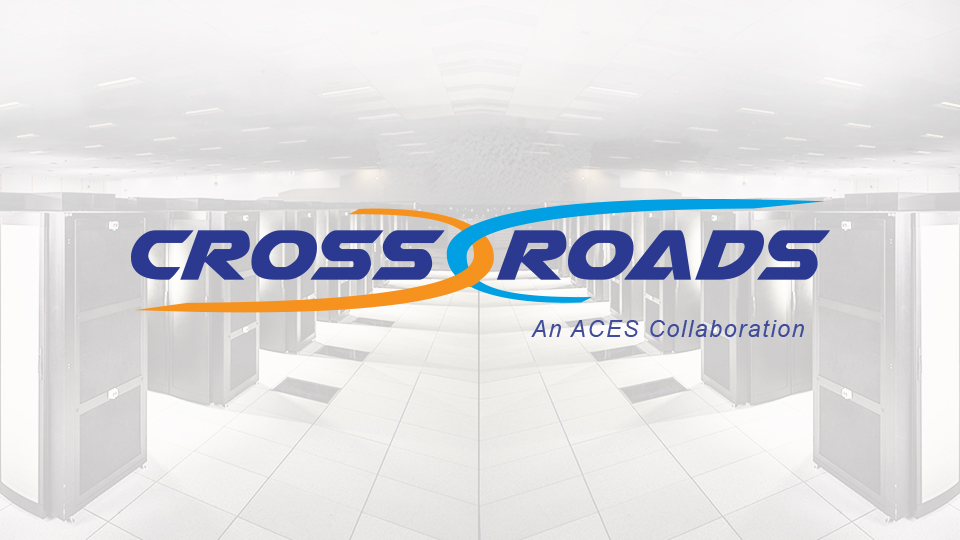
Just like Trinity was named for the first atomic bomb test, Crossroads is named for Operation Crossroads, during which two tests, Able and Baker, took place at Bikini Atoll.
Coming soon
The Crossroads request for proposal (RFP) was released in January 2019. As of October 2019, a vendor was selected, and contract negotiations are underway. This is the procurement phase of the project. Both Jim Lujan at Los Alamos and Jim Laros at Sandia will evaluate the design as the project progresses through procurement and the build phase. Expected delivery for Crossroads is in the fall of fiscal year 2021, and it is anticipated to be operational in fiscal year 2022.
“There will be about a six-month overlap between Trinity ramping down and Crossroads ramping up,” Lujan says. This will also be an “open science” period for Crossroads, meaning the supercomputer will be open to the greater scientific community to run large-scale, never-been-done-before problems in an unclassified environment.
Funding and missions
Crossroads is funded by the National Nuclear Security Administration via the Advanced Simulation and Computing Program. Crossroads supports the Laboratory’s Nuclear Deterrence mission and the Information Science and Technology science pillar. Technical contact: Jim Lujan
Chemistry
Technical strides in colloidal quantum dots
Colloidal quantum dots (QDs) are chemically synthesized semiconductor nanoparticles whose properties can be manipulated by exploiting fundamental laws of quantum mechanics. This allows for unprecedented control of their functionalities via means such as size and shape manipulation, atomic-level control of internal structure, and targeted placement of impurity atoms. Victor Klimov of Los Alamos’ Physical Chemistry and Applied Spectroscopy group is leading the Laboratory’s efforts in QDs, and he recently published two important articles, one in Science Magazine and another in Nature Nanotechnology.
Photochemical doping gives a boost to quantum dot lasers
Quantum dots have shown promise as solution-processable lasing media, but high lasing thresholds have held back technological advances in this area. Los Alamos researchers recently overcame this problem by photochemically doping QDs, thereby increasing optical-gain lifetimes and, as a result, lowering the lasing threshold. Solution processible QD lasers are of great potential utility in a wide range of emerging technologies, such as photonic integrated circuits, optical interconnects, lab-on-a-chip platforms, and devices for advanced medical diagnostics.
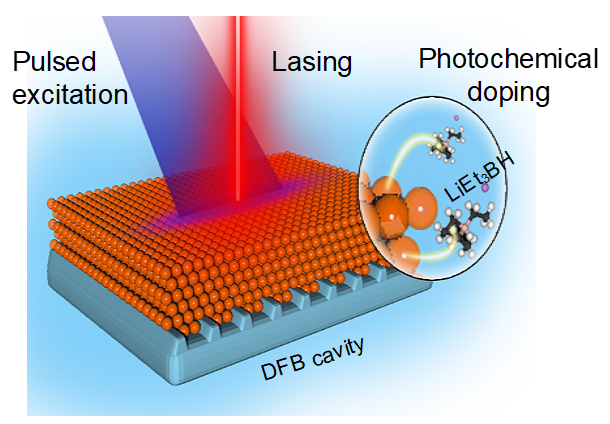
Schematic of a charged QD distributed-feedback (DFB) laser. This device is immersed into a solution of LiEt3BH, which acts as a sacrificial photo-reductant. Excitation of the QDs with short pulses of blue light leads to in situ QD photodoping with 2-to-3 extra electrons per-dot on average.
QD lasing with ultra-low “sub-single-exciton” thresholds
A standard approach to QD lasing uses two-exciton states or “biexcitons” as optical-gain species. This leads to high lasing thresholds as well as complications associated with very fast optical gain decay due to multi-exciton Auger recombination. In a new lasing scheme proposed by LANL researchers, this problem is resolved by using not neutral but negatively charged QDs containing approximately two extra electrons per dot. In this approach, lasing does not require biexcitons and can be initiated with less than one exciton per dot on average.
In fact, using their novel “charged-exciton” optical-gain mechanism, Los Alamos scientists demonstrated strong lasing under very unusual conditions when only a small fraction of the QDs in the gain medium (ca. 30%) were in the excited state while the rest remained unexcited. This is a favorable departure from the traditional lasing scheme wherein all dots in the sample contain at least one exciton and some contain two or more. The new QD lasing approach should facilitate the development of technologically viable solution-processible devices, which would help extend the reach of lasing technologies into areas not accessible with traditional epitaxially grown semiconductor materials.
Reference: Oleg V. Kozlov (C-PCS), Young-Shin Park (C-PCS; University of New Mexico), Jeongkyun Roh (C-PCS), Igor Fedin (C-PCS), Tom Nakotte (C-PCS; New Mexico State University), and Victor I. Klimov (C-PCS). “Sub-single-exciton lasing using charged quantum dots coupled to a distributed feedback cavity.” Science 365, 672–675 (2019). DOI: https://doi.org/10.1126/science.aax3489
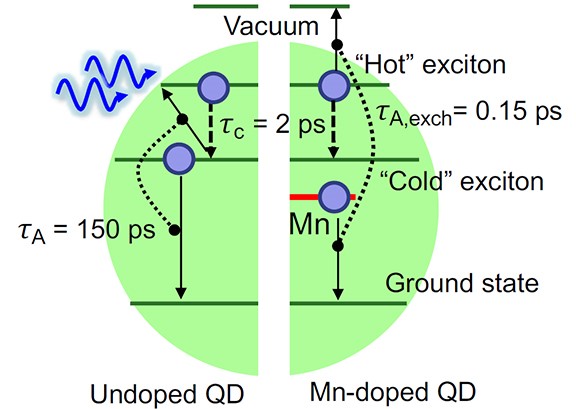
Doping a quantum dot with manganese (right) speeds the capture of energy from a hot electron to 0.15 picoseconds, outpacing losses to phonons in the crystal lattice.
Capturing “hot-carrier energy” with magnetically doped quantum dots
Upon absorption of a photon, an electron from an element’s valence shell can gain energy and move to a higher-energy conduction-band state. This effect is utilized in solar cells for converting sunlight into electricity. If the original photo-excited electron has a sufficiently high kinetic energy (i.e., is sufficiently “hot”) it can donate its energy to another electron from the valence shell, also exciting it to the conduction band. This process, called inverse Auger recombination or impact ionization, doubles a photocurrent, which can be used to boost the performance of solar cells.
Hot-carriers are ripe sources of energy, but actually harvesting that energy for use has proven challenging. Los Alamos researchers figured out a way to use magnetically doped QDs to efficiently capture hot-carrier energy via so-called “spin-exchange Auger energy transfer.”
“This discovery can potentially enable novel, highly-efficient solar cells, light detectors, photocathodes and light-driven chemical reactions,” said Victor Klimov, lead researcher in the Laboratory’s quantum dot effort.
Manganese dopants boost energy capture
The researchers doped the CdSe QDs with manganese, thereby enhancing the magnetic interactions between charge carriers. This boosts the spin-exchange Auger energy-gain rate more than tenfold, so it outcompetes intraband cooling and allows for hot-carrier energy capture. These findings open exciting opportunities for exploiting spin-exchange Auger processes in advanced schemes for photoconversion, high-speed photodetection, and photoemission.
Reference: Rohan Singh (C-PCS), Wenyong Liu (C-PCS), Jaehoon Lim (C-PCS; presently at Ajou University, Republic of Korea), Istvan Robel (C-PCS), and Victor I. Klimov (C-PCS). “Hot-electron dynamics in quantum dots manipulated by spin-exchange Auger interactions.” Nature Nanotechnology, October 7, 2019. https://www.nature.com/articles/s41565-019-0548-1
Funding and mission
The studies of charged QD photophysical properties and hot-electron dynamics were supported by the Solar Photochemistry Program of the Chemical Sciences, Biosciences and Geosciences Division, Office of Basic Energy Sciences, Office of Science, U.S. Department of Energy. The lasing studies were supported by the LDRD program at Los Alamos National Laboratory.
This research supports the Laboratory’s Energy Security mission and Materials of the Future science pillar. Technical contact: Victor I. Klimov
First polar organic functionality reduction mediated by vanadium catalysts
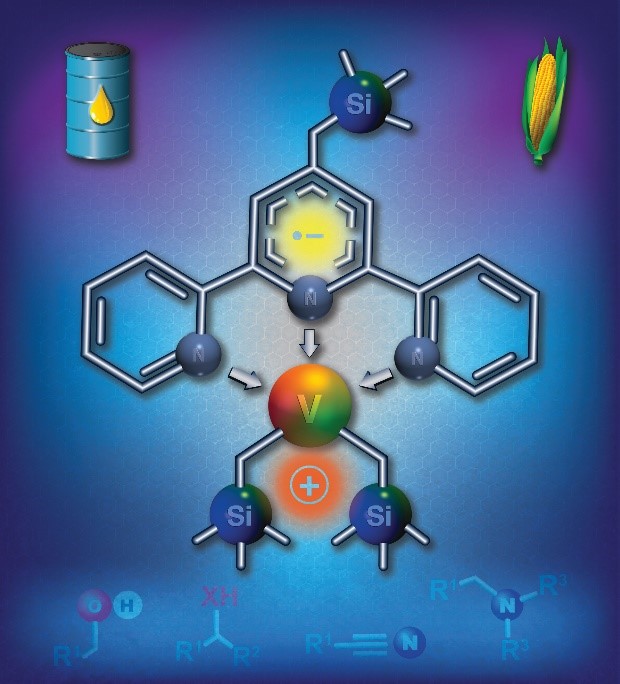
Oil from petroleum or corn can be catalytically converted to a range of useful products using a vanadium catalyst.
Catalysts advantageously increase the rate of a chemical reaction. It is common to design a catalyst centered upon a transition metal surrounded by ligands, which control the electronic and steric properties of the catalyst.
A Los Alamos researcher, Pavel Dub, along with former LANL Director’s Postdoctoral Fellow Guoqi Zhang (now at John Jay College) and former LANL Glenn T. Seaborg Postdoctoral Fellow Ryan Trovitch (now at Arizona State University), designed new catalysts based on the transition metal vanadium. With these catalysts, they reported the first examples of polar organic functionality reduction mediated by vanadium complexes. Their work was published in the Journal of the American Chemical Society.
Vanadium catalytic reductions are rare
Molecular complexes of vanadium are particularly useful and work as efficient catalysts for oxidation processes; however, their ability to catalyze reductive transformations has yet to be fully explored.
This research describes redox-noninnocent ligand-supported compounds of VIII and their use in the chemoselective hydroboration and hydrosilylation of fossil and bio-derived ketones, aldehydes, imines, esters, and carboxamides leading to value-added alcohols, amines, and nitriles. Their positive findings indicate that homogenous vanadium catalysts have been underutilized but should be reconsidered.
Funding and mission
This work was funded by the National Science Foundation, PSC-CUNY awards from John Jay College, and the Seed grant from the Office for Advancement of Research at John Jay College. The research supports the Laboratory’s Global Security mission area and Materials of the Future science pillar.
Reference: Guoqi Zhang (John Jay College), Jing Wu (John Jay College), Shengping Zheng (Hunter College), Michelle Neary (Hunter College), Jincheng Mao (Southwest Petroleum University, China), Marco Flores (Arizona State University), Ryan Trovich (Arizona State University), Pavel Dub (C-IIAC). “Redox-Noninnocent Ligand-Supported Vanadium Catalysts for the Chemoselective Reduction of C═X (X = O, N) Functionalities.” J. Am. Chem. Soc. 2019, 141, 38, 15230–15239. https://pubs.acs.org/doi/10.1021/jacs.9b07062
Computer, Computational and Statistical Sciences
‘Hackathon’ brings DOE labs together to solve CMIP data analysis challenge
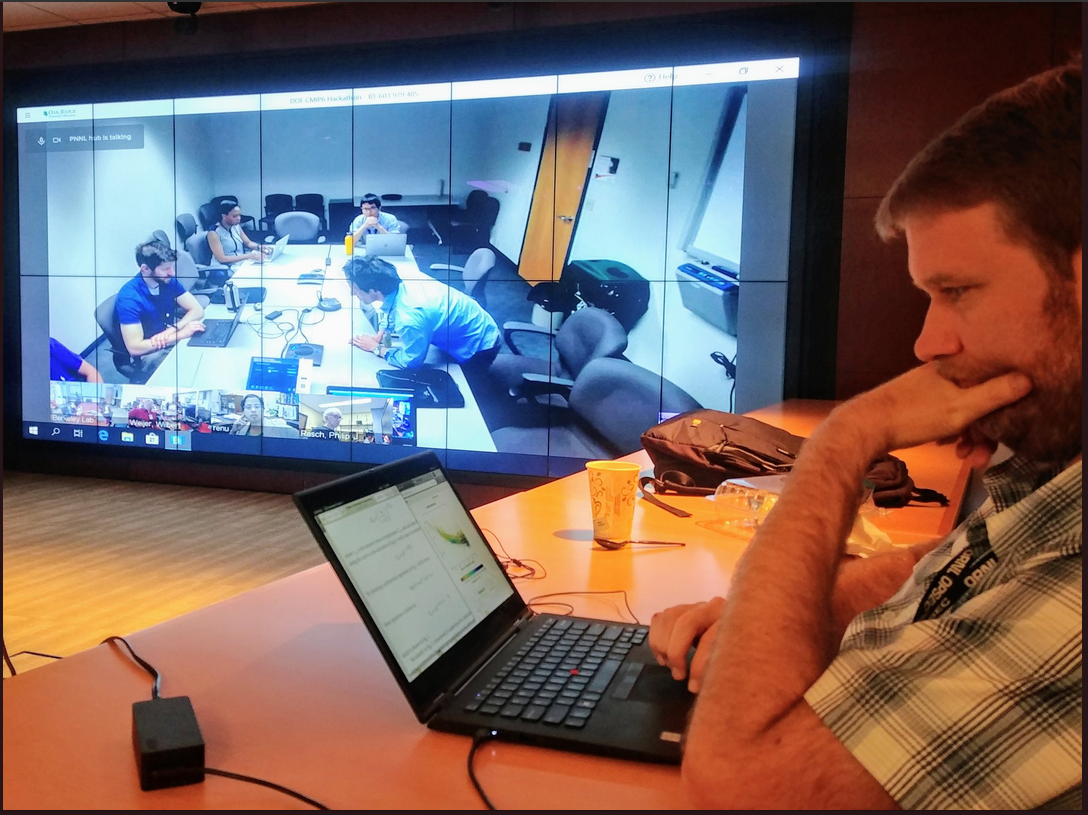
From the Oak Ridge National Laboratory Hackathon hub, teams from the other laboratories can be seen on a big screen. This live feed allowed for rapid collaboration during the event.
The Coupled Model Intercomparison Project (CMIP) began in 1995 with the goal of understanding past, present, and future climate changes. It builds on the principle that climate scientists can learn a lot about uncertainties in the climate's response to anthropogenic forcing (e.g., greenhouse gas concentrations in the atmosphere) by comparing simulations from different climate models driven by the same forcing scenarios.
CMIP is currently in its sixth phase (CMIP6), to which modeling centers worldwide are contributing simulations. A consortium of DOE laboratories, including Los Alamos National Laboratory, contribute simulations from DOE’s new Energy Exascale Earth System Model (E3SM). E3SM was developed specifically to support DOE’s energy security mission, and the LANL E3SM members recently received a large team Distinguished Performance Award for their success in climate modeling.
However, analyzing the CMIP6 archive is a considerable challenge, with the vast amount of data (tens of petabytes), the lack of a common analysis tool, and a diverse and loosely connected analysis community being important factors. To mitigate these problems, scientists from DOE’s Regional and Global Model Analysis (RGMA) program organized a coordinated CMIP6 analysis activity, which culminated in the CMIP6 hackathon.
One HPC platform, one analysis tool
The Hackathon was organized by LANL’s Wilbert Weijer (Computational Physics and Methods, CCS-2) in collaboration with project leads at the other laboratories. The event took place between July 31 and Aug. 6, 2019. In all, more than 50 scientists participated.
A single platform was used—a high-performance computer system of DOE’s National Energy Research Scientific Computing Center (NERSC). Petabytes of CMIP data were uploaded to dedicated storage space accessible from this platform, and a single DOE analysis tool was encouraged, called the Community Data Analysis Tool.
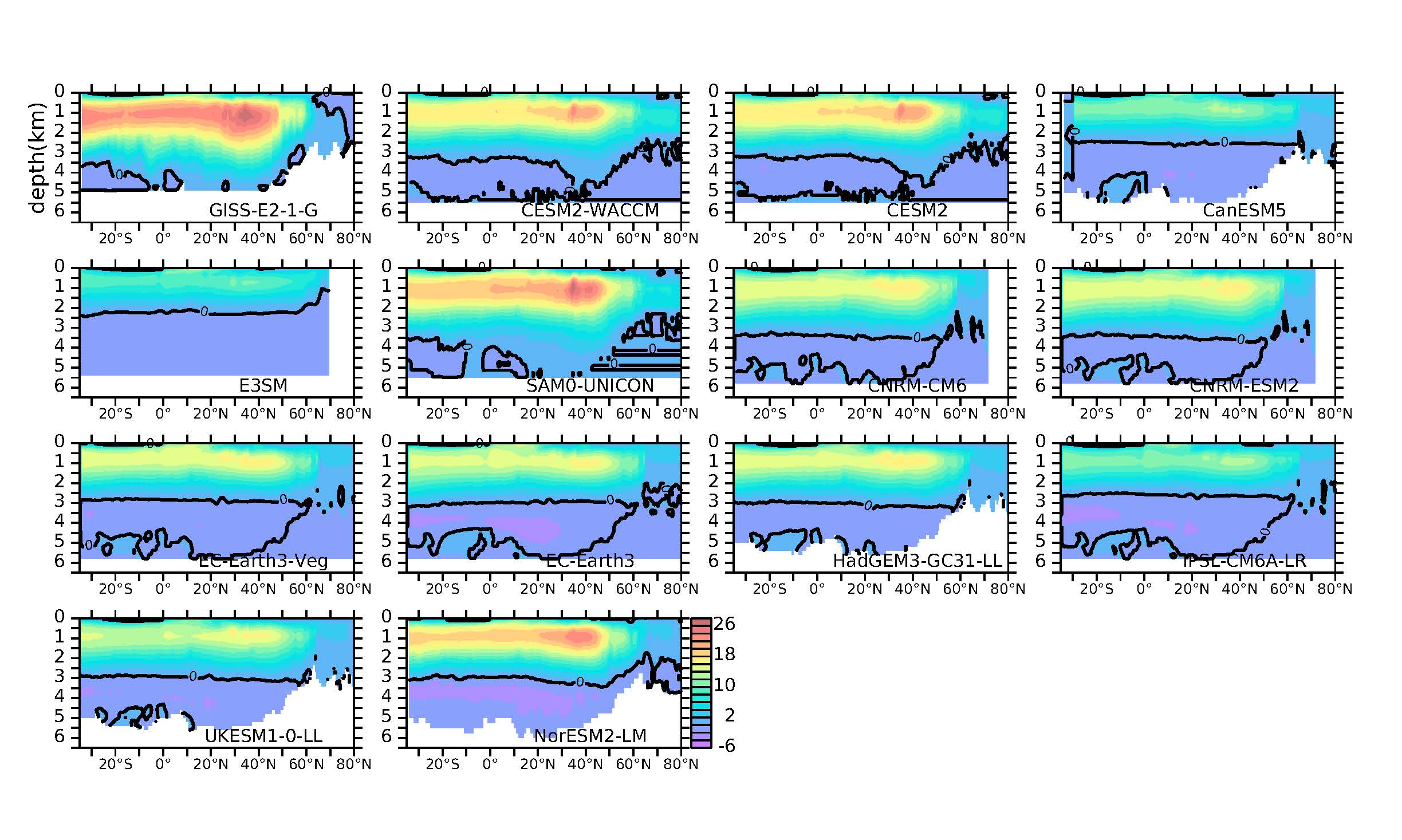
An example of a multi-model analysis using the Coupled Model Intercomparison Project archive, showing the representation of the Atlantic Meridional Overturning Circulation by different models.
The Hackathon allowed a large number of users to make rapid progress on meaningful science. “In the past, it would take months to find, download, organize, and then analyze large data sets like this,” says William Boos, an associate professor at the University of California, Berkeley. “But now, it took just a week or two because of the centralization of data and analysis tools.”
Results will be published in IPCC
The five-day collaboration helped build and tighten DOE’s climate modeling community. The results will provide input to the landmark Sixth Assessment Report of the Intergovernmental Panel on Climate Change (IPCC). The report is anticipated in 2021.
“We have contributed to a collective understanding of climate variability and change, and as a result, the research community will be better prepared to quantify the uncertainties that are inherent in climate projections,” said Weijer. “With lessons learned, we hope to organize similar activities in the future, including an even larger user base.”
Funding and missions
The Hackathon was funded by DOE’s Regional and Global Model Analysis program. The multi-institutional research supports the Laboratory’s Global Security mission area and the Information Science and Technology and Science of Signatures science pillars. Technical contact: Wilbert Weijer
New prediction tools for flu forecasting
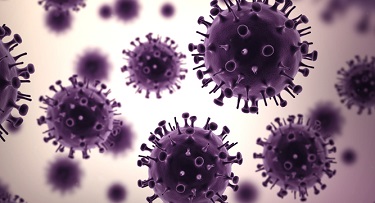
Each year the CDC estimates the flu burden to inform policy and communicate the impact of influenza and influenza vaccines.
The Centers for Disease Control and Prevention (CDC) traditionally measures influenza activity after it has occurred. However, forecasting where influenza is likely to strike before flu season is underway would better help people plan ahead and reduce flu impact. Estimated annual deaths due to flu are between 10,000 and 50,000.
FluSight is the CDC’s flu forecasting challenge open to scientists all over the world. This challenge encourages researchers to focus on the accurate prediction of flu spread. Three Los Alamos scientists are contributing their predictive modeling for the 2019–2020 flu season.
DBM+ and Dante+
The Los Alamos researchers created two forecasting models: DBM+ and Dante+. Both models are enabled with internet-based nowcasts, which means the forecasts are modified based on Internet data.
Flu data are released by the CDC at a one to two-week lag. The Los Alamos team fills in that gap by building a mathematical model to map geographically localized Google search volume data for flu-related terms (e.g., “cough” or “fever”) to CDC-issued flu data. The result is essentially peeking into the future to constrain possible trajectories of the flu, which leads to sharper and more accurate forecasts. Their research showed short-term forecasting is improved regionally and nationally with the addition of nowcasts.
Nowcasting takes an already favorable forecasting model, such as Dante, and brings it to the next level. Last year, Dante (without nowcasting) won first place in the FluSight 2018–2019 challenge. It will be entered this year as Dante+.
“Dante is a really important benchmark model for the flu-forecasting community, as it demonstrates what is possible with only CDC-issued flu data and sensible statistical modeling,” said Dave Osthus, lead Los Alamos flu modeler. “More data and more mechanistically motivated modeling bring with them the promise of improved forecasting. That’s why for the 2019–2020 flu season I am adding Internet-based nowcasting to Dante, making it Dante+.”
A simplified graphical representation of the Dynamic Bayesian Model (DBM). πt represents latent ILI nowcasting states, while yt represents available ILI nowcasting data. Shaded nodes represent observed quantities; unshaded nodes represent unobserved quantities. Directed edges represent dependencies between nodes.
Models differ in information sharing, but both are needed
DBM+ combines a mechanistic disease transmission model, a statistical discrepancy model, and Internet-based nowcasts to create forecasts nationally and regionally. The model is run independently at each geography, meaning no information is shared across space. Dante, on the other hand, does share information across geographies (i.e., states), which becomes more important as forecasts move to more actionable and local scales. Dante is a statistical model fit to all states jointly. Regional and national forecasts are generated as aggregations of state-level forecasts, resulting in coherent forecasts at all geographic scales. In general, DBM+ makes more conservative forecasts than Dante.
Flu-casting now is weather forecasting 60 years ago
Prospective flu forecasting has many challenges, including provisional, delayed, and noisy data; disconnects between disease transmission theory and the flu data-generating process; and barriers to communication with relevant stakeholders. These challenges also represent great opportunities. Disease forecasting over this past half-decade has proven logistically feasible, even though there is still a long way to go. Disease forecasting today is a lot like weather forecasting was 60 years ago—possible but in need of improvement. Just like weather forecasting, through consistent improvements to mathematical modeling and expanded access to relevant data, disease forecasting will grow in scope, usability, and impact.
Funding and missions
This work was supported in part by DOE through the LANL Laboratory Directed Research and Development (LDRD) program. The research supports the Laboratory’s Global Security mission area and Information Science and Technology science pillar.
References: Dave Osthus (Statistical Sciences, CCS-6), Ashlynn Daughton (Information Systems & Modeling, A-1), Reid Priedhorsky (HPC Environments). “Even a good influenza forecasting model can benefit from Internet-based nowcasts, but those benefits are limited.” PLOS Computational Biology. 2019. https://doi.org/10.1371/journal.pcbi.1006599
Dave Osthus (Statistical Sciences, CCS-6) and Kelly Moran (CCS-6; Duke University). “Multiscale Influenza Forecasting.” arXiv.org. https://arxiv.org/abs/1909.13766
Technical contact: Dave Osthus
Earth and Environmental Sciences
LANL team joins Arctic’s largest, longest research campaign
Los Alamos staff members from the Earth and Environmental Sciences (EES) Division Field Instrument Deployments and Operations (FIDO) team recently departed Norway aboard an icebreaker named the Polarstern, beginning a year-long drift locked in ice near the North Pole. Their work is part of the Multidisciplinary Drifting Observatory for the Study of Arctic Climate (MOSAiC) field campaign, the Arctic’s largest climate science expedition ever—and the first year-round.

Paul Ortega and David Chu (EES-14) join other institutions’ team members boarding the R/V Polarstern for months locked in the ice to study the Arctic.
For the $154-million collaboration, MOSAiC researchers are now in the central Arctic exploring the climate system, gathering data on how ice, atmosphere, and ocean systems are dynamically linked. MOSAiC is an international consortium that comprises 19 countries, more than 60 institutions, and 900 experts and support staff. The journal Science named MOSAiC one of the top stories of the year.
FIDO manages and operates research stations for the Department of Energy’s (DOE) Atmospheric Radiation Measurement (ARM) program, a major MOSAiC partner, to investigate how atmospheric factors affect the heat balance and the Arctic climate. The team manages one ARM fixed and two mobile facilities. Team members are staffing all six MOSAiC voyages, operating instruments aboard the icebreaker and on research camps installed on delicate ice. In addition to our MOSAiC expeditioners, other FIDO staff are in Norway operating another ARM Arctic campaign (COMBLE), supported by Los Alamos team members—scientists, engineers and international operations’ experts.
The LANL FIDO team manages and operates the ARM national user facility’s MOSAiC stations to investigate how atmospheric factors affect the heat balance and the Arctic climate. Team members are supporting all six MOSAiC voyages, operating instruments aboard the icebreaker and on research camps installed on delicate ice. The MOSAiC team must endure months of polar night, sub-zero temperatures, isolation, and a hostile, remote environment.
The team’s most logistically challenging deployment ever
“This is the largest experiment ever conducted in the Arctic,” said Jim Bossert, EES division leader. “The data collected has the potential to transform our understanding of the way the Arctic is responding to climate change—so important to improving our ability to predict global climate impacts of a rapidly changing Arctic environment.”

A polar bear and her cub inspect the waters near the icebreaker. Research stations on ice are protected by guards and a fenced perimeter. (Photo credit: LANL)
The Polarstern—supported by helicopters, other icebreakers, planes, and snowmobiles—left port and headed north in late September. The warming Arctic hampered attempts, but crews found a suitably thick ice floe to surround the Polarstern’s central observatory and provide a base for research stations installed on the constantly drifting ice. Teams overcame challenges—including a massive crevice that opened in the ice between the ship and the remote-operated vehicle site—and installed instruments on the Polarstern and an 11-meter-tall meteorological tower nearby. Polar bears have visited the well-protected site, and the sun last rose over the horizon two weeks ago.
The Arctic is warming faster than anywhere else on Earth. Recent decreases in arctic sea-ice coverage affects global weather and ocean circulation and increases warming. MOSAiC and COMBLE will contribute a quantum leap in our understanding of the coupled Arctic climate system and its representation in global climate models.
This research supports the Laboratory’s Global Security mission area and the Science of Signatures capability pillar. Learn more about the LANL FIDO team and about the ARM instrumentation and field campaign selection process. Technical contact: Heath Powers
Explosive Science and Shock Physics
Predicting safer explosives
LANL scientists discovered new correlations between molecular form and function, particularly as it relates to explosives sensitivity—the threshold at which an explosive reacts to destructive stimuli with defined probability. As scientists continue to hunt for new explosives, the ability to predict safety and sensitivity becomes quite valuable.
Spatial orientation affects sensitivity

L-ETN and D-ETN are enantiomers (mirror images) of each other, and both are diastereomers to ETN.
The researchers looked at stereoisomers—molecules composed of the same elements and connections but oriented in space in different ways—and found that stereochemistry plays a key role in explosive impact sensitivity. This is because modifying a compound’s orientation alters its physical properties, such as melting point.
Specifically, they studied a common initiating explosive erythritol tetranitrate (ETN), along with two of its isomers, L-ETN and D-ETN. This was the first recorded instance of L- and D-ETN synthesis, which turned out to be oils. Given that ETN is solid, direct comparison was difficult. Therefore, they also studied mannitol hexanitrate (MHN) as compared to its stereoisomer sorbitol hexanitrate (SHN). This is one of the first studies to consider stereochemistry with regard to explosive sensitivity in this growing field.
Liquid states and lower melting points increase sensitivity

Explosive stereoisomers MHN and SHN have the same connectivity but different spatial arrangements.
They found a significant difference in impact sensitivity between MHN and SHN, with SHN being more sensitive in the grit impact test. They also found L- and D-ETN were more sensitive than ETN. The study points to liquid states and lower melting points due to stereochemistry as the differentiating factor.
Knowing how stereochemistry plays a role in explosive sensitivity can help researchers predict effective yet safe molecules for future explosives. Manipulating the melting points of energetic materials may be a way of addressing handling sensitivity, offering significant advantages in explosives manufacturing and technology.
Reference: Nicholas Lease (M-7), Lisa M. Kay (M-7), Geoffrey W. Brown (M-7), David E. Chavez (M-7), Phil Leonard (M-7), David Robbins (Q-6), and Virginia W. Manner (M-7). “Modifying Nitrate Ester Sensitivity Properties using Explosive Isomers.” Crystal Growth Des. September 26, 2019. DOI: 10.1021/acs.cgd.9b01062
Funding and missions
This work was supported by the U.S. DOE. The use of the aluminum collar for temperature-controlled impact measurements was supported by the Laboratory Directed Research and Development program at LANL. This research supports the Laboratory’s Nuclear Deterrence mission area and Materials of the Future science pillar. Technical contact: Virginia Manner
Materials Science and Technology
Material semi-coherent interfaces impact properties, both desirable and undesirable
In the quest for enhanced functionality in materials, nanostructured materials are becoming more common. This is particularly true of oxide/oxide heterostructures in which interfaces (where two different materials meet) are frequent.
These interfaces can have positive effects, such as enhancing ionic conductivity, improving radiation resistance, and engineering strain across multiphase nanocomposites. In short, interfaces provide nanomaterials with desired properties. In fact, interfaces are being introduced into complex material systems to develop new properties.
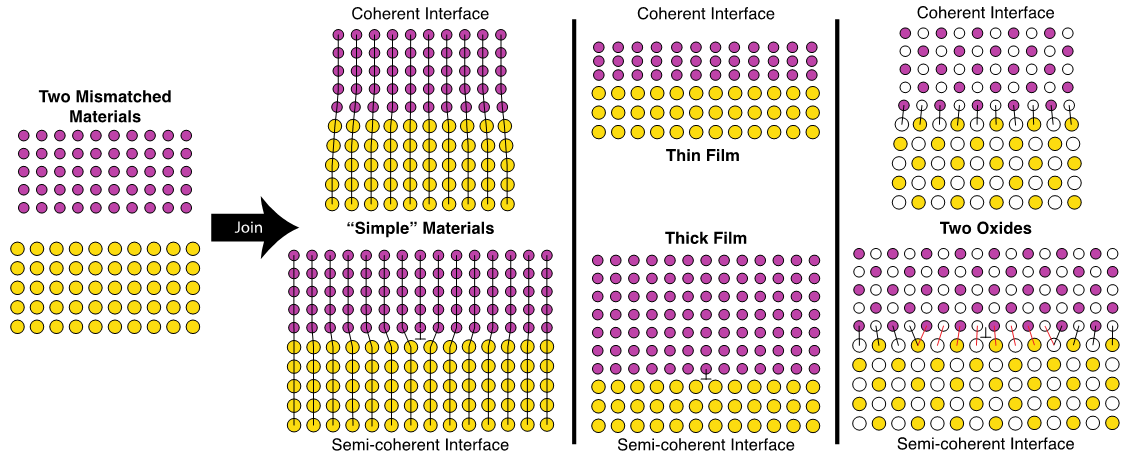
Semi-coherent oxide interfaces form when two oxides with different lattice constants are joined. Because of the mismatch between the materials, they cannot align one-to-one and defects (or misfit dislocations) form at the interface to accommodate that mismatch.
However, some interfaces are responsible for degradation, which is undesirable. Despite the importance and pervasiveness of interfaces in materials, there is still much that is unknown, particularly in oxide materials, about how these interfaces influence material properties.
Learning about interfaces in complex oxide materials
In research selected as an “Editor’s Pick” in APL Materials, Los Alamos materials scientists and their collaborator present a perspective on the importance of a specific type of interface, called a semi-coherent interface, in oxides.
In this invited work, the researchers investigate the misfit dislocations that define semi-coherent interfaces. These interfaces are complex because of the inherent material strain, which is common to all materials, including metals, as well as disrupted chemical bonding, which is unique to these types of systems where chemical and ionic bonds drive structure. They state that the exciting prospect of these interfaces is in driving performance. “In such cases,” the researchers explain, “any ability to modify the misfit dislocation network density or structure would provide another knob for tuning functionality.”
The application of these materials is quite broad; therefore, harnessing and controlling performance and functionality is advantageous, particularly at the atomic scale. There is still much to explore with semi-coherent interfaces, as they offer properties that coherent interfaces cannot.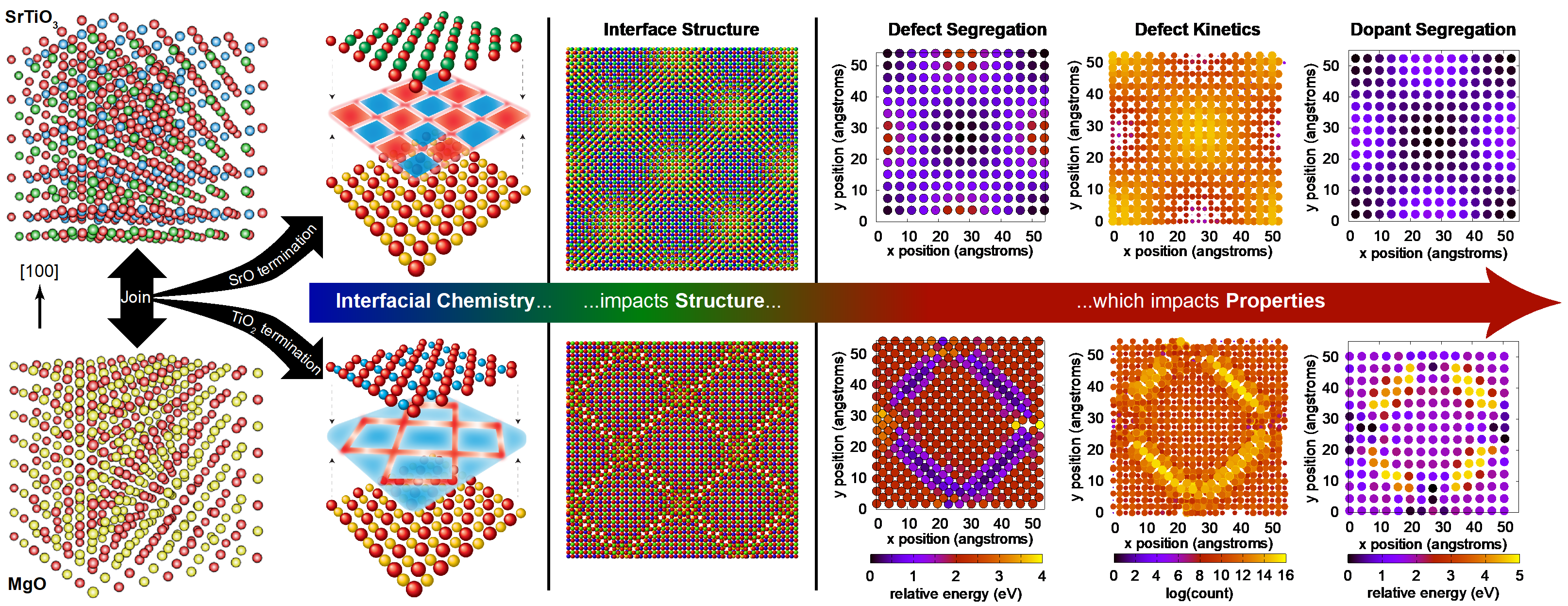
While only limited theoretical work has been done to examine the structure and properties of these interfaces, that work highlighted that misfit dislocation structures change fundamental properties at the interface, including the segregation of defects and dopants and mass transport at the interface.
Funding and missions
Funding for the Los Alamos portion of the work was provided by the DOE Office of Science, Basic Energy Sciences, Materials Sciences and Engineering Division and the Center for Integrated Nanotechnologies, an Office of Science User Facility operated by Los Alamos and Sandia national laboratories.
Reference: Blas Uberuaga (MST-8), Pratik Dholabhai (Rochester Institute of Technology), Ghanshyam Pilania (MST-8), and Aiping Chen (MPA-CINT). “Semi-coherent oxide heterointerfaces: Structure, properties, and implications.” APL Materials, 7 100904 (2019). DOI: https://doi.org/10.1063/1.5121027. Technical contact: Blas Uberuaga





